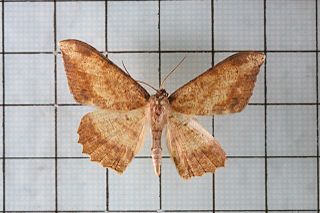Prout's hypothesis was an early 19th-century attempt to explain the existence of the various chemical elements through a hypothesis regarding the internal structure of the atom. In 1815 and 1816, the English chemist William Prout published two papers in which he observed that the atomic weights that had been measured for the elements known at that time appeared to be whole multiples of the atomic weight of hydrogen. He then hypothesized that the hydrogen atom was the only truly fundamental object, which he called protyle, and that the atoms of other elements were actually groupings of various numbers of hydrogen atoms.

Xanthorhoe is a genus of moths of the family Geometridae described by Jacob Hübner in 1825.

Avatha is a genus of moths in the family Erebidae.

Asthena is a genus of moths in the family Geometridae.

Chiasmia is a genus of moths in the family Geometridae. It was described by Jacob Hübner in 1823.

Chrysocraspeda is a genus of moths in the family Geometridae described by Charles Swinhoe in 1893.

Alcis is a genus of moths in the family Geometridae described by John Curtis in 1826.

Cyclophora is a genus of moths in the family Geometridae. Many species are referred to as mochas in reference to their colouration, primarily in Europe.

Luxiaria is a genus of moths in the family Geometridae first described by Francis Walker in 1860.
Psilocerea is a genus of moths in the family Geometridae described by Max Saalmüller in 1880.

Scopula is a genus of moths in the family Geometridae described by Franz von Paula Schrank in 1802.

Somatina is a genus of moths in the family Geometridae first described by Achille Guenée in 1858.

Dioptis is a genus of moths of the family Notodontidae. It consists of the following species:

Erbessa is a genus of moths of the family Notodontidae. It consists of the following species:
Polypoetes is a genus of moths of the family Notodontidae. It consists of the following species:
Louis Beethoven Prout (1864–1943) was an English entomologist and musicologist.

Luxiaria amasa is a moth in the family Geometridae first described by Arthur Gardiner Butler in 1878. It is found from south-eastern Siberia to Korea, Japan, northern India, Nepal, Taiwan, Borneo, Sumatra, Java and Sulawesi.
Luxiaria phyllosaria is a moth of the family Geometridae first described by Francis Walker in 1860. It is found in Sri Lanka, the north-eastern Himalayas of India, Sumatra, Borneo, the Philippines and Sulawesi.














